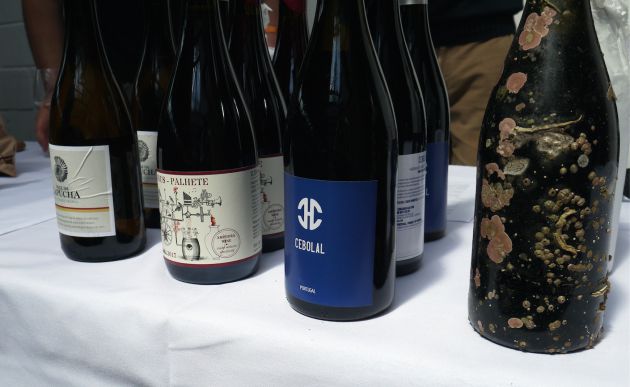
Ines Salpico: Portugal’s quiet wine revolution
London once again became the epicentre of the natural wine scene during the 2019 edition of the Real Wine Fair (RWF) earlier this month.
The event, organised by importer Les Caves de Pyrene, brought together 175 vignerons united by a similar approach to winemaking – low intervention, focusing on indigenous grape varieties and relying solely on indigenous yeasts – and by a shared commitment to sustainability.
A growingly important if still discreet presence is the Portuguese entourage that, since RWF’s first iteration in 2012, has gone from being a curiosity to a mainstay with faithful and knowledgeable following.
I was privileged to curate and host, alongside Dr.Jamie Goode, a masterclass on the “Portuguese Quiet Wine Revolution”, exploring the nature (all puns intended) of the changes that, in a relatively short period, altered the reality of Portugal’s wine offering.
The producers we invited for the discussion and whose wines we presented perfectly embody the main profiles of those currently leading this movement.
Present were: Vasco Croft of Aphros Wines who, having trained as an architect and without a viticultural background, pioneered biodynamic farming in Portugal and single-handedly changed the expectations for what a Vinho Verde must look and taste like; Pedro Marques, of Vale da Capucha, inherited land and vineyards but was the first in the family to study enology and take full control of operations, viticulture and winemaking, merging local awareness with influences from Burgundy, the Loire, Steiermark and beyond; and Luís Mota Capitão, of Herdade do Cebolal, who has been steadfastly introducing new sustainability standards and exploring the potential of local terroir and indigenous varieties after taking the helm of a 4th-generation family operation formerly working under conventional practices.
They represent the generation - educated and travelled, exposed to the international food and beverage trends, and fully immersed in the deluge of information that requires places and people to understand the local in order to be competitive globally – that has been driving a deep change in the Portuguese wine scene.
The revolution was therefore not really propelled from within, rather catalysed by an exposure to international trends and by a structural change in consumers’ profiles.
It was also contextualised by the growing international visibility and appreciation of iconic enfant-terribles such as Luis Pato and Dirk Niepoort.
Having long championed indigenous varieties, a deep understanding of terroir as well as a gentler approach to winemaking, their wines gained prominence in export markets – baffling many of the big players in the Portuguese wine industry - at a time when sommeliers and knowledgeable drinkers seek lower-alcohol, expressive pours with a story to tell.
The fact that somewhat lost traditions suddenly became hipster-worthy only helped the cause: red Vinho Verde, low in alcohol and traditionally served chilled on hot summer days is notably reminiscent of the Beaujolais Nouveau renaissance; Vinhos de Talha (wines fermented in big clay vessels) perfectly fitted the Georgian qvevri craze; Palhete (blend of co-fermented white and red varieties) tied in with the growing interest in ancestral field-blends. Slowly but surely this allowed for a reassessment of the country’s heritage and inspired the new generation of Portuguese vignerons.
Being Portuguese myself and having grown up tailing my grandfather in his vineyards and cellar, I can only say that the trendy wines of today are the wines my grandfather made.
For most of us – millennial (I cringe at the word but if one must…) winemakers, critics, sommeliers – tasting and making these so called 'new wave' wines is an exercise of nostalgia, research and soul-finding, combined with a novel concern for environmental and social sustainability.
The outcome are wines that depart from the standard 'vinho da casa' (house wine) that was – and largely still is – served at all Portuguese restaurants and has long set consumers’ expectations of what a Portuguese wine must be (i.e. either a full-bodied red, high in alcohol and over-extracted, or a crisp white, straight and uncomplicated).
The wines we seek and make are layered and textured, with nuances that derive from different soil types, microclimates, altitudes and exposures; wines with a quenchable alcohol/acidity balance that express specific regions and vintages; bottles whose longevity will rely on subtle textural layers rather than on extraction and gritty tannins.
What seemed to be the critical challenge for this new wave of winemakers and brands might not be such a dramatic dilemma after all. If five years ago it would seem unlikely that their wines could be placed at a just price point in international markets, many key producers are now actually struggling to fulfil demand. In the category these wines are competing in – ‘natural’, food friendly, alcohol restrained – they offer competitive prices (namely for the on-trade) and provide great stories for a table-side sale (and in any case customers are increasingly seeking experience and meaning over value-for-money).
These are indeed exciting times for Portugal’s viticulture and winemaking. Of course many challenges lie ahead mostly due to the infamous climate-change pressures. Local varieties once again have a key role to play, uniquely adapted as they are to the landscape and terroir. One can only be hopeful about and proud of the vibrant, forward-looking community that is ready to face these challenges and is making expressive, terroir-specific wines. Look elsewhere if you want the cheapest ex-cellar prices; look here if you’re looking for a revival of centuries-old traditions with a contemporary outlook and without unreasonable trend-premiums.




